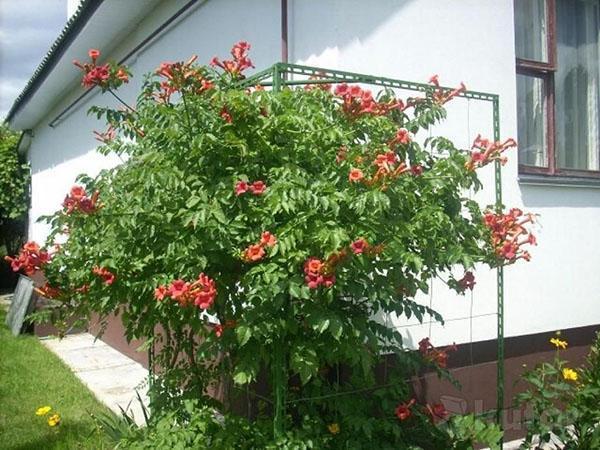Cultivation of kampsis: what you should know before planting an aggressive vine on the site
 If you love vines and there is a free space in the country, plant a kampsis there. Cultivation of kampsis is possible even for novice gardeners due to its absolute unpretentiousness. Curly lashes will quickly hide the most unsightly area under them. And large orange bells will make an unprepossessing corner a real decoration of the summer cottage. However, it is worth thinking twice before planting this perennial. Why? We will tell you about this today.
If you love vines and there is a free space in the country, plant a kampsis there. Cultivation of kampsis is possible even for novice gardeners due to its absolute unpretentiousness. Curly lashes will quickly hide the most unsightly area under them. And large orange bells will make an unprepossessing corner a real decoration of the summer cottage. However, it is worth thinking twice before planting this perennial. Why? We will tell you about this today.
What you need to consider when planning to plant Kampsis
First of all, it is worth noting the fact that the breeding of a liana-like perennial is possible only in one case: the presence of a free area. If there is a place on your site that is not planted with garden, garden and flower crops, feel free to settle Kampsis there. It could be fence, territory near outbuildings, an abandoned shady corner in the garden ... In general, the main criterion for choosing a place for a vine is the presence of free territory, that is, space for growth. Why is this so important? Because Kampsis is a very aggressive vine. Its root system grows deeper, but expands strongly on the sides, capturing territories within a radius of 2 meters or more. Naturally, no other crops will grow on this piece of land - the liana will simply "crush" them.
Having decided to save on support, do not plant Kampsis near the arch with grapes. The scourge of the shrub grows quickly and can reach a length of up to 7 m. They drown out the grapes and deprive you of your harvest.
Cultivation of kampsis: are there any subtleties of caring for a perennial vine
So, we figured out the landing site, now about whether it needs your participation for development. If yes, then only the minimum. The shrub is able to grow on almost any soil, and absolutely without additional fertilizing. The most time-consuming part of caring for it is regular pruning. That's really really what you can't do without. Otherwise, impassable thickets will form from one bush in a couple of years. But the stems almost do not need special tying. Only in young bushes you need to install supports and direct the branches at first. In the future, Kampsis firmly "sticks" to any support, be it a tree, a fence or a pillar, with aerial roots.
However, this vine is not so "bad" plant for the garden. The positive characteristics of growing kampsis include the following:
- blooms profusely and for a long time;
- rarely gets sick;
- almost not damaged by pests;
- in warm regions it winters well even without shelter;
- if it freezes in winter, it quickly recovers;
- even if the central stem is damaged, it grows a new aerial part within a couple of years.